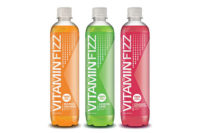What Can Your Beverage Do for You?
By Elizabeth Fuhrman
New fortification formulations add function
The alignment of consumer
wellness concerns, progression of beverage
ingredient technology and research linking diet to disease prevention have
formed the perfect market for functional products. Consumer interest in
ingredients that might improve their health in some way has spurred an
increase in new functional beverage products and the growth of new
functional ingredients and technologies for these products.
Fortified/functional beverages, excluding dairy,
reached more than $19 billion in 2006, with fortified/functional milk and
flavored milk drinks adding another approximately $728 million to the
category, according to Euromonitor International, Chicago. By 2011,
Euromonitor projects that fortified/functional beverages will reach more
than $29 billion in the United States, with fortified/functional milk and
flavored milk drinks growing slower, to $815 million domestically.
| Top functional and fortification claims for new beverages | ||
Number of new products |
||
| Product claims | YTD 7/31/07 | YTD 7/31/06 |
| Vitamin/mineral fortified | 190 | 148 |
| Functional - other | 31 | 28 |
| Added calcium | 24 | 23 |
| Functional - cardiovascular | 10 | 7 |
| Weight control | 8 | 9 |
| Functional - immune system | 7 | 1 |
| Functional - digestive | 7 | 4 |
| Functional - beauty benefits | 5 | 1 |
| Whole grain | 5 | 0 |
| Added fiber | 5 | 4 |
| Functional - brain and nervous system | 4 | 5 |
| Functional - bone health | 2 | 0 |
| Antioxidant | 1 | 1 |
| Source: Mintel Global New Product Database, U.S. launches | ||
Functional ingredients provide a health benefit beyond
basic nutrition in beverages, and these drinks often are bestowed labeling
that includes the words “fortified,” “enhanced” and
“dietary supplement.” Too much of a good ingredient
doesn’t seem to worry some beverage manufacturers either. Some
fortified beverages launch with more than 200 percent the daily value of
certain vitamins. “These substances provide essential nutrients,
often beyond quantities necessary for normal maintenance, growth and
development and/or other biologically active components that impart health benefits of desirable physiological effects,”
states the Institute of Food Technologists (IFT) Expert Report on
Functional Foods: Opportunities and Challenges.
Developing functional products
Numerous challenges arise when meeting
consumers’ needs for healthy ingredients and manufacturers’
needs for delivery systems free from formulation problems. To take on these
concerns, the IFT Expert Panel developed a seven-step process outlining the
design, development and marketing of functional foods and beverages. After
identifying a potential new functional ingredient (Step 1), the
ingredient’s efficacy and safety must be established (Step 2 and 3).
When selecting an appropriate product for the
bioactive ingredient (Step 4), one must consider characteristics of the
beverage, the ingredient and the intended consumer. An independent peer
review and regulatory oversight (Step 5) double checks the accuracy of the
health claims, which must be properly communicated to consumers (Step 6).
Finally, in-market surveillance confirms the findings of the pre-market
assessments (Step 7).
Formulation issues can include appearance, taste,
texture, stability and flavor, says Mark Fanion, corporate communications
manager of Fortitech Inc., Schenectady, N.Y.
“Certain nutrients are not very soluble so
product manufacturers and formulators have to select the correct market
form of the ingredient to avoid the sedimentation,” Fanion explains.
“Certain nutrients may also give a bitter aftertaste and some are not
very stable; others may be light and/or heat sensitive.”
Fortitech has designed more than 20,000 custom
premixes to address these issues. “Our custom premixes are fully
customized to address the developer’s intended marketing and consumer
needs,” Fanion says.
New benefits
While formulators are handling the logistics of
incorporating new functional ingredients, consumers’ desires are
changing and rapidly requiring new functional beverages and fortification
to meet their needs. As of July 31, 2007, vitamin and mineral fortification
topped the claims manufacturers made about their new product introductions,
according to Mintel’s Global New Products database. So far this year,
more than 15 percent of the products introduced included a vitamin and
mineral fortification. Added calcium, cardiovascular, weight control,
immune system, digestive, beauty benefits, brain and nervous system and
bone health also made the list.
Fortified beverages can be tailored to meet the
special dietary needs of a specific age group, gender, athlete or ailment.
Tackling wellness concerns, Eagan, Minn.-based Biothera’s Wellmune
WGP aims to enhance key immune responses. One
of the 2007 IFT Food Expo Innovation Award
winners, Wellmune WGP improves the body’s immune defense against
foreign invaders by enhancing the ability of white blood cells to fight
bacteria, viruses, fungi and parasites. The ingredient is available as a
soluble and insoluble powder for a wide range of beverages, including clear
liquids.
“Wellmune WGP meets the growing demand from
food manufacturers and consumers for natural ingredients with real immune
health benefits that are backed by credible science and safe for daily
consumption,” said Richard Mueller, Biothera president and chief
executive officer, in a statement.
| Ingredient usage in U.S. beverages | ||
| Chicago-based Euromonitor International Inc.’s new information system “Passport: Ingredients” measures the use of ingredients in consumer products. For functional ingredients, “Passport: Ingredients” tracked the fortifications below for use in U.S. beverages: | ||
Volume(in tons) |
||
| Ingredients | 2001 | 2006 |
| Total minerals | 8,292.0 | 8,427.1 |
| Calcium | 7,808.0 | 7,998.2 |
| Magnesium | 162.2 | 135.8 |
| Other minerals | 321.8 | 293.0 |
| Total proteins | 1,465.8 | 1,413.7 |
| Whey | 614.7 | 498.0 |
| Total vitamins and derivatives | 855.4 | 1,107.8 |
| Vitamin B group | 60.1 | 159.4 |
| Vitamin C | 782.9 | 936.5 |
| Vitamin E | 12.4 | 11.9 |
| Source: Euromonitor International, Passport: Ingredients | ||
The Dow Chemical Co., Midland, Mich., also won a 2007 IFT Food Expo Innovation Award for its Fortefiber
Soluble Dietary Fiber. Derived from cellulose, the dietary fiber product is
odorless and tasteless, and offers a combination of functional and health
benefits. Clinical studies on the product have demonstrated significant
lowering of blood glucose, insulin and cholesterol levels, the company
says.
Taking into consideration consumers’ taste
preferences and digestion functions, Fortefiber does not affect the taste
or texture of the finished product. Additionally, the product won't cause
gas or bloating when used at typical product formulation levels because it
is non-fermentable.
Ingredients are coming into the market not only for
health and digestion but for brain function too, and entering in new
beverage categories. Jones Soda Co. signed an agreement with Pharma Foods
International Co. Ltd., Kyoto, Japan; Mitsubishi Corp., Tokyo; and
Mitsubishi International Food Ingredients Inc., Dublin, Ohio, that gives
Jones the exclusive rights to an anti-stress ingredient in beverage
applications.
The ingredient, Pharma Gaba is a naturally produced
form of the amino acid gamma-aminobutric acid (Gaba), a neurotransmitter in
the human brain that has been shown to exert a number of anti-stress
effects, along with other benefits. Used as an ingredient in Japan, Pharma
Gaba received GRAS status in the United
States.
“Securing the rights to Pharma Gaba is the key
step in our development of an entirely new type of Jones energy
beverage,” said Peter van Stolk, president and chief executive
officer of Jones Soda.
Rather than produce a stimulant effect like
caffeine-containing energy beverages, Jones Soda plans to use the
ingredient to promote mental focus. The company plans to work with Michael
Murray, chairman of Dr. Murray Natural Living Inc. and a leader on natural
food products research, in the development of the new energy beverage. The
line is expected to be available at select retail locations by this winter.
Small, but powerful
In the realm of functional, sometimes the formulation
of a wellness beverage begins on a small scale with new scientific
technologies. Nanotechnology takes the small stuff seriously.
Nanotechnology focuses on the characterization,
fabrication and manipulation of biological and nonbiological structures
smaller than 100 nanometer (nm). To put into scale, 1 nm is a billionth of
a meter, and can be used as encapsulation and delivery systems to carry,
protect and deliver functional ingredients to their specific site of
action.
This year, Phlo Corp., Jacksonville, Fla., began
shipping sports drinks that feature the company’s Instant Nano
Hydration (through nano-encapsulation technology) and Cell Armor
technologies. In this case, the nano-encapsulation technology prevents the
destruction of nutrients in the stomach, the company says.
P.L. Thomas & Co., Morristown, N.J., and Mishor
Adumin, Israel, also won a 2007 Institute of Food Technologies Food Expo
Innovation Award for its NutraLease nano-encapsulation technology. The
patented ingredient and nutraceutical delivery system for beverage and food
applications can improve the bioavailability of some healthy compounds.
Incorporation of bioactives is definitely one of the
key areas of emerging use, says Jochen Weiss, PhD, assistant professor in
the Department of Food Science at the University of Massachusetts and one
of the authors of IFT’s November/December
2006 Scientific Status Summary Functional Materials in Food Nanotechnology.
“Bioavailability of components can be greatly
increased by nano-encapsulation and activity/stability may be maintained in
various environments,” Weiss says. “For minerals (e.g. iron),
problems with stomach ulcer upon fortification remain, and
nano-encapsulation may prevent interaction and damaging of the stomach
value.”
In addition, nano-structured systems allow
encapsulation of lipid materials while maintaining transparency, and
creaming and destabilization is not an issue due to the small size.
Research also shows some benefits may exist in terms of stability and light
adsorption when encapsulating pigments. Currently, Weiss is working with
companies to develop more efficient, long-term active preservation systems
using nano-encapsulation.
With food safety at the top of consumer awareness,
nanotechnology can be used as a tool to increase security of manufacturing,
processing and shipping of food products through sensors for pathogen and
contaminant detection.



